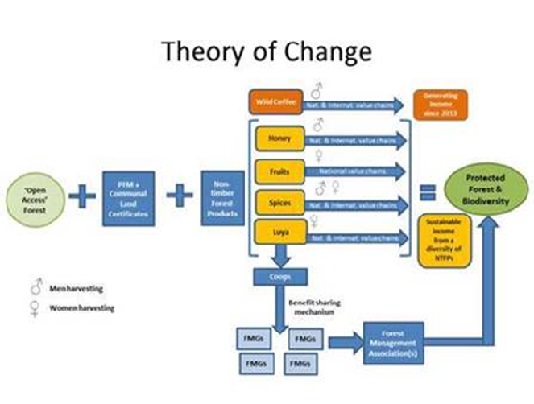Non-Timber Forest Products micro-enterprises project (NTFP-ME)
Project Design
The NTFP-ME project was designed after a careful participatory assessment of the potential development of trade in NTFPs from the four woredas of operation. This assessed the way specific NTFPs can help make forests a more competitive land use and provide economic opportunities, especially for women.
This project works with seven cooperatives, representing communities across all four districts. These cooperatives provide central storage and collection points. They allow their facilities to be used by the 12 NTFP-MEs which have been established. The coops are linked to the Forest Management Associations which group together all the community / village level FMGs in a district. The FMAs ensure that the FMGs undertake their management duties, including biodiversity monitoring and forest protection and so ensure sustainable harvesting of NTFPs.
The project seeks to redress gender imbalance in commercial activities by placing women at the centre of NTFP micro-enterprise development. Each district has at least one micro-enterprise led by women, with women’s roles in the management of the coops and most micro enterprises enhanced. The design process identified forest fruits, spices (long pepper, Ethiopian cardamom and wild chillies) and seeds (forest mahogany or luya) as most relevant for women, while honey was chosen as having the most immediate potential impact, with transitional hives helping to make bee keeping accessible to women. Each NTFP has a specific value chain and requires different types of support which the project is addressing.
A key element of this support is linking the local MEs and Cooperatives with private sector actors who can provide training to ensure products are of an appropriate standard. The private sector also provides links to market and advises on how value chains can be managed to keep the maximum benefits with the communities.
In each district the Micro-Enterprises (MEs) have prioritised those products most relevant to their communities using information on availability and accessibility of NTFPs from the regular FMG forest patrols and local knowledge.
The project has been designed to address a number of the issues raised by international conventions relating to biodiversity and the sustainable development goals. With respect to the conventions the project activities pay specific attention to:
Convention on Biological Diversity: managing biological resources using indigenous knowledge and increased forest income to ensure sustainable use.
Aichi Biodiversity Targets and Nagoya Protocol: sustaining forest production, maintaining carbon stocks, valuing biodiversity, generating benefits for all, with improved access for women, through the development of NTFP value chains.
With respect to the Sustainable Development Goals, particular concerns are with:
SDG1.2 Reduce number living in poverty: with NTFP value chain development providing additional opportunities for income generation.
SDG5.5 Women’s full and effective participation: through a focus on gender equity, support for women’ active participation and ring-fencing. leadership roles in micro-enterprises and co-ops for women.
SDG15.2/5/6 Sustainably manage forests; halt biodiversity loss: Forest management plans of existing FMGs now include sustainable harvesting of forest products traded by MEs and maintenance of biodiversity. Increased income will encourage community commitment to the sustainable management of forest and protection of its resources.
SDG 12.2 Sustainable management of natural resources: : Amount of forest products harvested will be controlled and monitored through the forest management plans developed by the existing FMGs and signed off by local government.
SDG 16 Peace and Justice; effective, accountable and transparent institutions: Micro-enterprises will be linked to existing co-ops and operate under the coop’s member-generated bylaws. Coops have democratic elections for management committee roles, hold AGMs and publish accounts.
The output of this planning process was the development of a Theory of Change to guide the project work.
